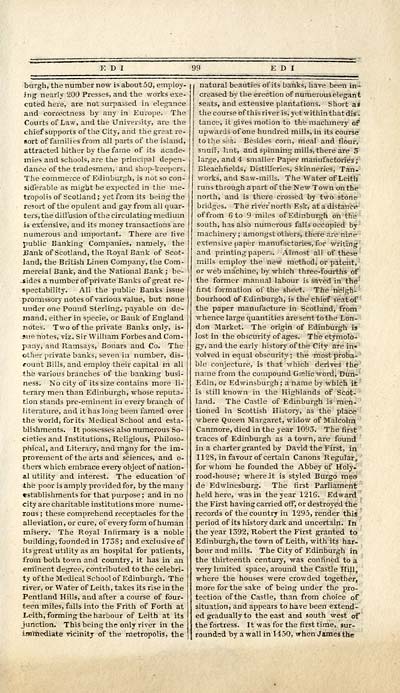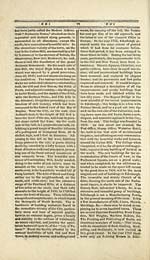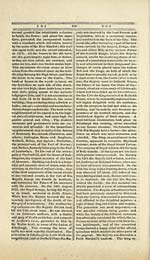Gazetteer of Scotland
(101) Page 99
Download files
Complete book:
Individual page:
Thumbnail gallery: Grid view | List view

EDI
burgh, the number now is about 50, employ-
ing nearly 200 Presses, and the works exe-
cuted here, are not surpassed in elegance
and correctness by any in Europe. The
Courts of Law, and the University, are the
chief supports of the City, and the great re-
sort of families from all parts of the island,
attracted hither by the fame of its acade-
mies and schools, are the principal depen-
dance of the tradesmen, and shop-keepers.
The commerce of Edinburgh, is not so con-
siderable as might be expected in the me-
tropolis of Scotland; yet from its being the
resort of the opulent and gay from all quar-
ters, the diffusion of the circulating medium
is extensive, and its money transactions are
numerous and important. There are rive
public Banking Companies, namely, the
Bank of Scotland, the Royal Bank of Scot-
land, the British Linen Company, the Com-
mercial Bank, and the National Bank ; be-
sides a number of private Banks of great re-
spectability. All the public Banks issue
promissory notes of various value, but none
under one Pound Sterling, payable on de-
mand, either in specie, or Bank of England
notes. Two of the private Banks only, is-
sue notes, viz. Sir William Forbes and Com-
pany, and Ramsays, Bonars and Co. The
•other private banks, seven in number, dis-
count Bills, and employ their capital in all
the various branches of the banking busi-
ness. No city of its size contains more li-
terary men than Edinburgh, whose reputa-
tion stands pre-eminent in every branch of
literature, and it has long been famed over
the world, for its Medical School and esta-
blishments. It possesses also numerous So-
cieties and Institutions, Religious, Philoso-
phical, and Literary, and many for the im-
provement of the arts and sciences, and o-
thers which embrace every object of nation-
al utility and interest. The education of
the poor is amply provided for, by the many
establishments for that purpose ; and in no
city are charitable institutions more nume-
rous ; these comprehend receptacles for the
alleviation, or cure, of everyform of human
misery. The Royal Infirmary is a noble
building, founded in 173S; and exclusive of
its great utility as an hospital for patients,
from both town and country, it has in an
eminent degree, contributed to the celebri-
ty of the Medical School of Edinburgh. The
river, or Water of Leith, takes its rise in the
Pentland Hills, and after a course of four-
teen miles, falls into the Frith of Forth at
Leith, forming the harbour of Leith at its
junction. This being the only river in the
immediate vicinity of the metropolis, the
natural beauties of its banks, have been in-
creased by the erection of numerouselegant
seats, and extensive plantations. Short a»
the course of this river is, yet within that dis -
tance, it gives motion to the machinery of
upwards of one hundred mills, in its course
to the sea. Besides corn, meal and flour,
snuff, lint, and spinning mills, there are 5
large, and 4 smaller Paper manufactories;
Eleachfields, Distilleries, Skinneries, Tan.
works, and Saw-mills. The Water of Leith
runs through apart of the New Town on the
north, and is there crossed by two stone
bridges. The river north Esk, at a distance
of from 6 to 9 miles of Edinburgh on the
south, has also numerous falls occupied by
machinery ; amongst others, there are nine
extensive paper manufactories, for writing
and printing papers. Almost all of these
mills employ the new method, or patent,
or web machine, by which three-fourths of
the former manual labour is saved in the
first formation of the sheet. The neigh-
bourhood of Edinburgh, is the chief seat of
the paper manufacture in Scotland, from
whence large quantities are sent tothe Lon-
don Market. The origin of Edinburgh is
lost in the obscurity of ages. The etymolo-
gy, and the early history of the City are in«
volved in equal obscurity ; the most proba-
ble conjecture, is that which derives the
name from the compound Gaelic word, Dun-
Edin, or Edwinsburgh ; a name by which it
is still known in the Highlands of Scot-
land. The Castle of Edinburgh is men-
tioned in Scottish History, as the place
where Queen Margaret, widow of Malcolm
Canmore, died in the year 1093. The first
traces of Edinburgh as a town, are found
in a charter granted by David the First, in
112S, in favour of certain Canons Regular,
for whom he founded the Abbey of Holy-
rood-house; whereit is styled Burgo meo
de Edwinesburg. The first Parliament
held here, was in the year 1216. Edward
the First having carried off, or destroyed the
records of the country in 1295, render this
period of its history dark and uncertain. In
the year 1392, Robert the First granted to
Edinburgh, the town of Leith, with its har-
bour and mills. The City of Edinburgh in
the thirteenth century, was confined to a
very limited space, around the Castle Hill,
where the houses were crowded together,
more for the sake of being under the pro-
tection of the Castle, than from choice of
situation, and appears to have been extend-
ed gradually to the east and south west of
the fortress. It was for the first time.'sur-
rounded by a wall in 1450, when James the
burgh, the number now is about 50, employ-
ing nearly 200 Presses, and the works exe-
cuted here, are not surpassed in elegance
and correctness by any in Europe. The
Courts of Law, and the University, are the
chief supports of the City, and the great re-
sort of families from all parts of the island,
attracted hither by the fame of its acade-
mies and schools, are the principal depen-
dance of the tradesmen, and shop-keepers.
The commerce of Edinburgh, is not so con-
siderable as might be expected in the me-
tropolis of Scotland; yet from its being the
resort of the opulent and gay from all quar-
ters, the diffusion of the circulating medium
is extensive, and its money transactions are
numerous and important. There are rive
public Banking Companies, namely, the
Bank of Scotland, the Royal Bank of Scot-
land, the British Linen Company, the Com-
mercial Bank, and the National Bank ; be-
sides a number of private Banks of great re-
spectability. All the public Banks issue
promissory notes of various value, but none
under one Pound Sterling, payable on de-
mand, either in specie, or Bank of England
notes. Two of the private Banks only, is-
sue notes, viz. Sir William Forbes and Com-
pany, and Ramsays, Bonars and Co. The
•other private banks, seven in number, dis-
count Bills, and employ their capital in all
the various branches of the banking busi-
ness. No city of its size contains more li-
terary men than Edinburgh, whose reputa-
tion stands pre-eminent in every branch of
literature, and it has long been famed over
the world, for its Medical School and esta-
blishments. It possesses also numerous So-
cieties and Institutions, Religious, Philoso-
phical, and Literary, and many for the im-
provement of the arts and sciences, and o-
thers which embrace every object of nation-
al utility and interest. The education of
the poor is amply provided for, by the many
establishments for that purpose ; and in no
city are charitable institutions more nume-
rous ; these comprehend receptacles for the
alleviation, or cure, of everyform of human
misery. The Royal Infirmary is a noble
building, founded in 173S; and exclusive of
its great utility as an hospital for patients,
from both town and country, it has in an
eminent degree, contributed to the celebri-
ty of the Medical School of Edinburgh. The
river, or Water of Leith, takes its rise in the
Pentland Hills, and after a course of four-
teen miles, falls into the Frith of Forth at
Leith, forming the harbour of Leith at its
junction. This being the only river in the
immediate vicinity of the metropolis, the
natural beauties of its banks, have been in-
creased by the erection of numerouselegant
seats, and extensive plantations. Short a»
the course of this river is, yet within that dis -
tance, it gives motion to the machinery of
upwards of one hundred mills, in its course
to the sea. Besides corn, meal and flour,
snuff, lint, and spinning mills, there are 5
large, and 4 smaller Paper manufactories;
Eleachfields, Distilleries, Skinneries, Tan.
works, and Saw-mills. The Water of Leith
runs through apart of the New Town on the
north, and is there crossed by two stone
bridges. The river north Esk, at a distance
of from 6 to 9 miles of Edinburgh on the
south, has also numerous falls occupied by
machinery ; amongst others, there are nine
extensive paper manufactories, for writing
and printing papers. Almost all of these
mills employ the new method, or patent,
or web machine, by which three-fourths of
the former manual labour is saved in the
first formation of the sheet. The neigh-
bourhood of Edinburgh, is the chief seat of
the paper manufacture in Scotland, from
whence large quantities are sent tothe Lon-
don Market. The origin of Edinburgh is
lost in the obscurity of ages. The etymolo-
gy, and the early history of the City are in«
volved in equal obscurity ; the most proba-
ble conjecture, is that which derives the
name from the compound Gaelic word, Dun-
Edin, or Edwinsburgh ; a name by which it
is still known in the Highlands of Scot-
land. The Castle of Edinburgh is men-
tioned in Scottish History, as the place
where Queen Margaret, widow of Malcolm
Canmore, died in the year 1093. The first
traces of Edinburgh as a town, are found
in a charter granted by David the First, in
112S, in favour of certain Canons Regular,
for whom he founded the Abbey of Holy-
rood-house; whereit is styled Burgo meo
de Edwinesburg. The first Parliament
held here, was in the year 1216. Edward
the First having carried off, or destroyed the
records of the country in 1295, render this
period of its history dark and uncertain. In
the year 1392, Robert the First granted to
Edinburgh, the town of Leith, with its har-
bour and mills. The City of Edinburgh in
the thirteenth century, was confined to a
very limited space, around the Castle Hill,
where the houses were crowded together,
more for the sake of being under the pro-
tection of the Castle, than from choice of
situation, and appears to have been extend-
ed gradually to the east and south west of
the fortress. It was for the first time.'sur-
rounded by a wall in 1450, when James the
Set display mode to: Large image | Transcription
Images and transcriptions on this page, including medium image downloads, may be used under the Creative Commons Attribution 4.0 International Licence unless otherwise stated. ![]()
| Gazetteers of Scotland, 1803-1901 > Gazetteer of Scotland > (101) Page 99 |
|---|
| Permanent URL | https://digital.nls.uk/97422906 |
|---|

